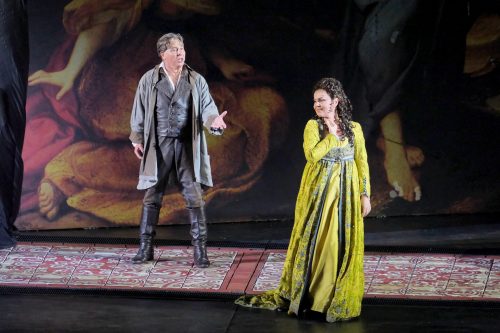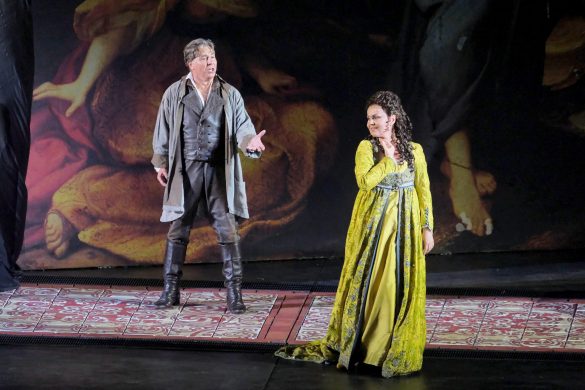 Italy Puccini’s Tosca at the 100th Arena di Verona Opera Festival 2023 [3]: Soloists, Children’s Choir (conductor: Elisabetta Zucca), Chorus (chorus director: Roberto Gabbiani) and Orchestra of Arena di Verona / Francesco Ivan Ciampa (conductor). Recorded (directed by Barbara Napolitano) at the Arena di Verona on 29.7.2023 and available on RaiPlay for a limited time. (JPr)
Italy Puccini’s Tosca at the 100th Arena di Verona Opera Festival 2023 [3]: Soloists, Children’s Choir (conductor: Elisabetta Zucca), Chorus (chorus director: Roberto Gabbiani) and Orchestra of Arena di Verona / Francesco Ivan Ciampa (conductor). Recorded (directed by Barbara Napolitano) at the Arena di Verona on 29.7.2023 and available on RaiPlay for a limited time. (JPr)

Production:
Direction, Set design, Costumes, Lighting design – Hugo de Ana
Cast:
Floria Tosca – Aleksandra Kurzak
Mario Cavaradossi – Roberto Alagna
Baron Scarpia – Luca Salsi
Cesare Angelotti – Giorgi Manoshvili
The Sacristan – Giulio Mastrototaro
Spoletta – Carlo Bosi
Sciarrone – Dario Giorgelè
A Shepherd – Erika Zaha
This was the first Tosca performance of the 100th Arena di Verona Festival 2023 though I have already reviewed here a subsequent one on 5.8.2023 with Sonya Yoncheva and Vittorio Grigòlo. I don’t expect readers to look back to that recent review so will repeat some of what I wrote then.
Tosca surely needs no introduction and these sentences from Verona’s website can suffice: ‘Puccini’s Tosca premiered in 1900, blending his established melodic and harmonic genius with a gripping immediacy, reminiscent of a cinematic thriller. This captivating story, crafted by Sardou, Illica, and Giacosa, coupled with Puccini’s unmatched theatrical intuition, creates a masterpiece brimming with dramatic tension and unforgettable arias […] It is no wonder Tosca, the sixth most performed title at the amphitheatre, commands a place in this year’s Festival repertoire.’ The current production which I have now seen twice in such a short time was premiered in 2006 and the set, costumes and lighting was the vision of Argentinian director Hugo de Ana and the website continues how this Tosca ‘has been successfully revived several times in recent decades. Sumptuous period costumes harmoniously blend with classic settings and imposing scenes, resonating with the spirit of the story. The unique stage seamlessly adapts to the three settings of the libretto, portraying the thriller set in nineteenth-century papal Rome, amid Bonapartist revolutionaries, opulence, darkness, mystery, and the iron rule of the ruthless Baron Scarpia. The colossal statue of the archangel Michael, symbolising divine justice and more, adds a compelling visual element.’
This is an unashamedly traditional Tosca and de Ana shows us in the broadest terms those ‘three settings of the libretto’: inside the church of Sant’Andrea della Valle, Scarpia’s apartment in the Palazzo Farnese and the top of the Castel Sant’Angelo. Of course the intimacy of Tosca will be lost in the vastness of the famous Roman amphitheatre of 30 AD though watching it again, as here, on RaiPlay you get the best seat in the house. The TV director Barbara Napolitano seemed to have been given a new toy and shots from a drone high above the arena frequently interrupted what we saw, but on the plus side she had cameras in the wings which pulled those watching on a screen right into the drama onstage. In Act II never have I seen Scarpia’s attempted rape of Tosca so realistically – and horrifyingly – portrayed as in this staging.
At the start the Sacristan enters down the steps to the side of the vast stage with four misbehaving friars who will proceed to drag Cavaradossi’s workbench towards the vast painting of Jesus and Mary Magdalene he will be working on. There is much playing around with some preliminary sketches he has done. Much else on the stage is initially draped in black although we see a vast hand with a rosary, hint of a wall and some cannons on either side at the front. Later the painting is taken down and the huge head of archangel Michael is revealed and a large crucifix and two equally big candlesticks are brought on for the Te deum when there is more than a hint of Giorno dei Morti (Day of the Dead) to de Ana’s over-populated procession and the priests visible above the stage.
In close-up the costumes appeared well-worn but everyone looked as you would expect them to for Rome at the very beginning of the nineteenth century. Tosca was in embellished gold, bejewelled red and plainer blue during the three acts and sashayed around with her various shawls; Scarpia has some very elaborate frock coats; and Roberto Alagna was possibly wearing his own Cavaradossi leather costume or maybe Vittorio Grigòlo did later in the run as they looked a little different. Scarpia’s apartment consisted of little more than two large (coffin-like) carved wooden chests with some odds and ends on them such as decanters and wine glasses, a crucifix and candelabra of course, as well as some seashells, a ham and a skull. Oddly, the torturing of Cavaradossi remains unseen and below a trapdoor and Tosca seemed to find the knife she used to kill Scarpia stuck in part of what scenery there is.
For the last act, Cavaradossi is first spied in his cell high up at the back whilst two of the street urchins we first encountered in Act I are shown fishing in the Tiber (the orchestra pit!). There is a cross to which Cavaradossi will be loosely manacled as he is shot by the firing squad and Tosca does not jump from any ramparts but is last seen (or a double is?) with her back to the audience atop archangel Michael’s head with a crucifix in her right hand.
I wrote before how Francesco Ivan Ciampa was a name new to me and described the performance I heard through my loudspeakers as a ‘correct’ one. Here on the first night Puccini’s rollercoaster of passion, blackmail, deception and murder sounded as good as I have ever heard it and Ciampa conducted with clarity of vision, dynamism and searing intensity. Once again the highlight was the rich, colourful palette of sound Ciampa encouraged from his virtuosic musicians during the third act’s orchestral prelude depicting dawn in Rome.

I previously suggest Verona mostly demands all the principal singers just fill their lungs and sing forte all the time. I am grateful to a triumvirate of remarkable singing actors for proving this does not need to be case. Those watching the close-up camerawork saw dramatic – and realistic – acting worthy of straight theatre. I believed Aleksandra Kurzak, Roberto Alagna and Luca Salsi really were Floria Tosca, Mario Cavaradossi and Baron Scarpia. I became so involved in what I was watching that at the end when Cavaradossi bids farewell to Tosca with a lingering kiss – as he doesn’t believe he will survive the supposed ‘fake’ execution – I found myself unusually overcome by the emotion of it all and there was a tear in my eye.
The singing of the three principals was unutterably glorious: Roberto Alagna defies the years and acted and sang as well as ever. His charismatic Cavaradossi had a jovial side but he was also capable of fiery bursts of revolutionary zeal, as well as revealing his deep affection for Tosca. Alagna brought vocal resplendence to ‘Recondita armonia’ and highlights were his full-throated ‘Vittoria! Vittoria!’ and the subsequent cursing of Scarpia and Tosca whilst being dragged away. ‘E lucevan le stelle’ was plaintively conversational; he then caressed ‘O dolci mani’ and the subsequent duet was extraordinarily tender and deeply affecting (as I have suggested).
Aleksandra Kurzak was a playful – outwardly devout – Tosca flirting irresistibly with Cavaradossi in the first act, yet her insecurity and jealousy was plain to see. As politics, her lover’s torture and the threat of sexual violence make her world implode Kurzak’s voice had a darker edge to it with all the exclamations of horror and outrage viscerally delivered. De Ana gives Tosca almost a solo moment in the spotlight for ‘Vissi d’arte’ and Kurzak’s torment was clear to all and this pivotal aria was one of the most deeply moving performances of it I have ever seen and heard.
Luca Salsi was an equally remarkable Baron Scarpia, the sadistic police chief, and he brought to him some flashes of humanity – however repulsive – and impressively revealed the psychology of his character who openly compares himself to Iago. Salsi’s Scarpia exuded ingratiating confidence but was a scheming and successful – in the worst sense – sexual predator. His singing was convincingly malevolent and Salsi took great care with the meaning of all his words. Notably, his ‘Ebbene?’ (‘Well?’) when hinting at what Tosca must do to save her lover was as chilling as the ‘Muori! Muori! Muori!’ Kurzak’s Tosca spat out vengefully after she despatched Scarpia
In the very solid supporting cast who I had heard before, Giorgi Manoshvili impressed as Cavaradossi’s fellow revolutionary Angelotti, Giulio Mastrototaro was a typically bustling Sacristan and Carlo Bosi stood out – as he always does in character tenor parts throughout the world – as Scarpia’s conniving henchman Spoletta. In the role of the Shepherd I suspect the winsome Erika Zaha elicited quite a few ‘ahhhhhhhs’ from the Verona audience.
Just one final word about this Tosca: brilliant!
Jim Pritchard
